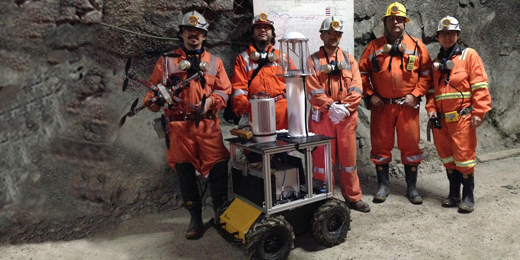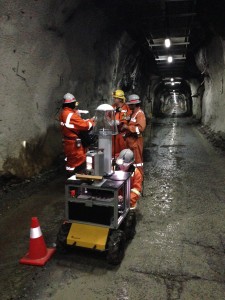Chile’s open pit mines are challenging environments with harsh atmospheric conditions – danger lurks in every corner! That’s why Dr. Martin Adams’ research team at University of Chile is driven to minimize manpower in the mines. To do this, however, it means that complex sensing and automation solutions are necessary to complete the tasks that people are currently doing, like shovel-loading and transportation …which then of course means that reliable interpretation of sensor data is pretty darn important, particularly for 3D rock surface profile estimation and 3D mapping. Dr. Adams’ team has stepped up to the challenge to find out why registration problems happen and how data collection in these harsh mining environments can be improved – all for the noble cause of removing humans from danger.
The project is called Autonomous Rock Surface Modelling and Mapping in Mines. You see, in the past decade, new technologies from the multi-source, multi-target research field have provided methods that allow sensor data to be processed so that both the number and location of objects of interest can be estimated in a statistically joint manner. However, “existing technologies are in early-stage development and require refinement,” explains Adams. “Our project develops existing technologies so that terrain surface profile and mine mapping information can be extracted from noisy sensor data.”
The goods and gadgets
The teams’ project was designed to collect motion characteristics from Husky and noise characteristics from radar, laser and vision-based sensors to model open pit and underground mines. Data fusion from different vehicle positions was then carried out for consistent surface profile and mine map estimation. “The Husky mobile platform was a very strong fit for our project in terms of payload capacity and ability to handle harsh terrain,” explains Adams.
A millimeter wave radar was used for its unique ability to penetrate dust and other accruing atmospheric substances, providing valuable information missed by other sensors. Meanwhile, the team analyzed the robustness of laser-based feature detection by collecting data to determine a comparison of detection probabilities and false alarms in rugged environments.
Visual-based feature detection algorithms such as the Speeded-Up Robust Feature (SURF) detection were also analyzed to determine the applicability of information extraction for mapping and surface profiling in mines.
The Husky platform was chosen for the sensor-based experiments within the project because of its robustness, payload capability and open-source compatibility. All of the data collection and software processing algorithms used throughout the project were based on the Robot Operating System (ROS); “Husky’s compatibility with ROS made experiments run smoothly in terms of communicating between processes, sensors and the Husky itself;” says Adams.
Contributing to future mining operations
Since initiating the project, Dr. Adams’ team has discovered the registration problems associated with combining data from different sensors in a challenging environment. To do so, they have applied a variety of scan matching techniques and analyzed the acquired laser and radar data to improve the automatic detection of useful mine-based features. These features can be reliably extracted at multiple robot locations for the purpose of robotic navigation and mapping.
The 3D Riegl scanning laser range finder and an Acumine 2D scanning millimeter wave radar were transported on Husky and used to record video footage and densely sampled data sets. The data is being submitted to the International Journal of Robotics Research to ensure that information is available to the international robotics community, providing insight for ongoing research in the field. Lastly, a leading mining company in Chile has expressed interest in acquiring similar robotic systems to enable staff to control vehicles and therefore acquire 3D maps within their mines; discussions with this company are underway. “Our Husky-based sensing system will contribute significantly to the success and efficiency in which future mining operations take place,” says Adams.
See what this Husky’s sensors see, in the 3D Point Cloud Mine Mapping video here:




